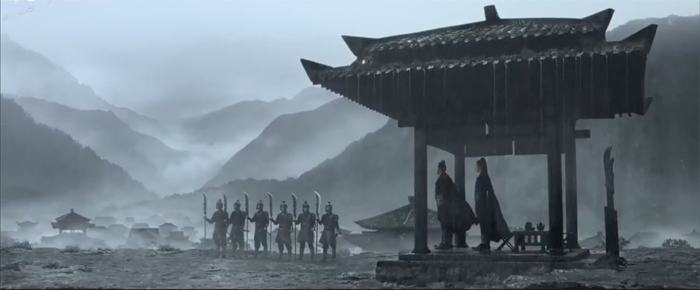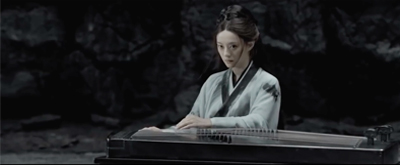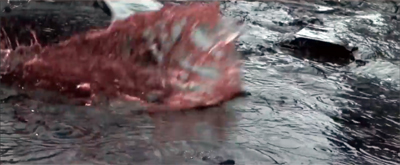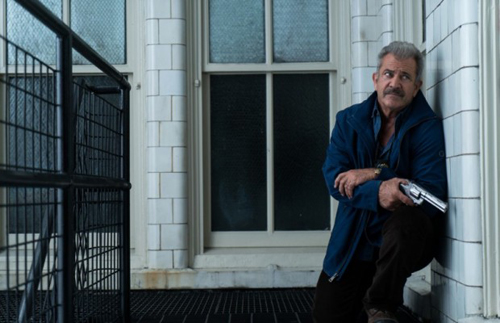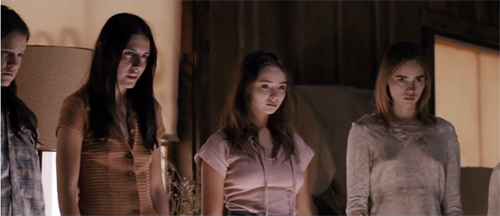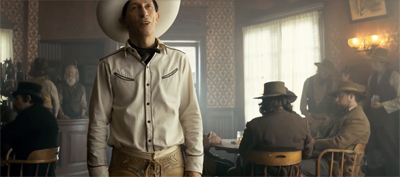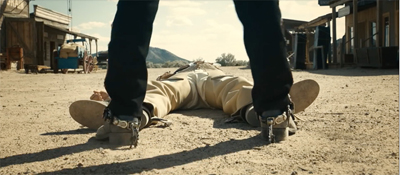Venice 2018: Assorted malefactors
Thursday | September 13, 2018 open printable version
open printable version
Ying (Shadow).
DB here:
You don’t have to be an addict of crime fiction to notice that bad behavior–from lying and cheating to assault and murder–is a prime motivation in all genres of storytelling. A gripping plot often depends not on innocent mistakes but something worse: an assassination plot (Macbeth), a savage robbery (Crime and Punishment), wicked mind games (Les Liaisons dangereuses). Some of my favorite films from the latest Venice Film Festival feature scurrilous intrigue and a whole lot worse. Hell, in one movie the subject was happy to be compared to Satan, and that was a documentary.
Shadow warrior
After the extravagantly peculiar Great Wall, Zhang Yimou has come back with a more sober, somewhat arty wuxia drama. Leaning a bit on the premise of Kurosawa’s Kagemusha, Ying (Shadow) presents a king trying to reclaim territory with the aid of a crafty general. But he’s relying on a ringer; the real general languishes in a secret chamber recovering from a severe wound. Court intrigue–the general’s wife falls in love with her husband’s double, the king’s sister resents his manipulation of her–builds toward a massive military attack on the Jing stronghold. The sister, in rebuff to the enemy’s insult to her, enlists in the ranks as well.
It’s quite a show. For one thing, Zhang has reengineered the color-design principles of Hero. There each flashback episode was keyed to a different palette.
In Ying, the settings exist almost entirely in deep blacks and soft grays. For most of the film, only flesh and blood are given in their natural colors, and even then they are pastels.
For another thing, in contrast to the overcast skies of Hero and in perhaps another Kurosawa nod, here it’s almost always raining. This constant downpour extends the gray-black color palette of the palace to the massive landscapes.
Above all, the training of the young imposter in a technique of fighting with a metallic umbrella leads to some memorable combat sequences. Little do we realize in the initial practice sessions that the umbrella technique will expand on a grand scale. Pei’s troops invade a town using umbrellas as bobsleds, and they attack the enemy with umbrellas as scythes and buzzsaws. Despite the fact that digital rain doesn’t bounce off shoulders or trickle down the tracery of armor, the water-drenched attack at the climax of Ying yields the tingling sense of tactile spectacle that we’ve come to expect from the maker of Red Sorghum.
Cops and/as crooks
Dragged Across Concrete (production still).
In another but not wholly different genre, we have S. Craig Zahler’s Dragged Across Concrete. I was unfamiliar with his two earlier features, Bone Tomahawk and Brawl in Cell Block 99, though alert viewer Dave Kehr urged me to see the latter last year. (I tried, on streaming, but I gave up because the image was too small; Zahler’s eye is calibrated for the big screen.) Now, seeing this latest enterprise smashed across the Lido’s Darsena screen, I’m here to declare myself a fan.
It’s got a neat structure. There are two protagonists. We’re first introduced to Henry Johns, a discharged prisoner. He’s ready to reenter a life of crime to keep his disabled brother safe and rehabilitate his mom, who’s tricking to support her drug habit. After twenty minutes, he drops out of the plot and we pick up Brett Ridgeman, a cop whose menacing interrogation techniques, captured on cellphone video, result in a suspension. Pressed by money problems and his wife’s MS, Ridgeman decides to get “proper compensation” by ripping off a gang planning a heist. Of course Henry and Ridgeman’s trajectories intersect, while drawing in others: Henry’s sideman Biscuit, Ridgeman’s partner Anthony, and a woman working at the company that’s the target of the robbery.
At two and a half hours, Dragged Across Concrete might seem to be an overinflated genre movie, but it owes its leisurely pace, I think, to the tradition of crime novelists like Lionel White, George V. Higgins, Elmore Leonard, and George P. Pelicanos. In their work crime, duplicity, betrayal, and revenge are at the center of a web of human relations. Unrestricted narration follows outlaws, cops, and bystanders whose fates will be intertwined with acts of violence. You need a certain amount of time to give solidity to the lives of these stakeholders in criminal action.
The sweep of such plotting allows us to appreciate irony, especially when characters misjudge each other’s motives. In Zahler’s film, the split structure of the narration–setting up Henry before we see Ridgeman–pays off in several ways. Having access to the frustrations that push Henry back into crime allows us to judge Ridgeman’s occasional bursts of bigotry as both understandable (given the treatment of his daughter in the neighborhood) but no less hateful. At the climax, there’s a crisis of trust that depends on mutual ignorance. Both Henry and Ridgeman err because each man doesn’t know something crucial about the other.
The film’s length is also warranted by Zahler’s classical approach to composition and cutting. He knows how to exploit anamorphic widescreen, to let the camera stay still and watch action unfolding.
The film’s title summons up Sam Fuller sensationalism (and Zahler’s overheated prose in his novels isn’t far removed from Sam’s). But the film reminded me of Jean-Pierre Melville and Kitano Takeshi, partly for the laconic dialogue but also for the deliberate pacing. (The average shot length is 6.5 seconds, about twice what we find in most Hollywood movies today.) Lacking Tarantino’s self-congratulatory flamboyance, Dragged Across Concrete exemplifies the power of a dry but not unemotional approach to genre conventions.
The Forties, yet again
Charlie Says.
Police thrillers like Dragged Across Concrete became salient creative options in the 1940s, as I tried to suggest in my book about that era in Hollywood. Other 1940s options surfaced in two other crime-based movies I saw at Venice.
The first, rarer choice, was the chaptered film, the movie broken into blocks that are marked as distinct. Meet Me in St. Louis does it by season, Holiday Inn by, well, holidays. We’ve become used to chaptering since Pulp Fiction revived the scheme.
In The Ballad of Buster Scruggs, Joel and Ethan Coen literalize the technique by beginning with an old-fashioned book consisting of six chapters. The tales all center on the American West, and each one is introduced by a captioned color plate and ends with a glimpse of the closing passages of text.
This direct address to the audience is carried on in the first episode, “You seen ’em, you play ’em.” Here the gunslinger Buster Scruggs tries to charm us while singing “Cool Water.” The conceit is that a fancy-pants singing cowboy is planted in the grubby, dangerous west of actual history.
At first Buster dispatches fast-draw artists, but when he meets his match he’s lofted to heaven in a goofy cadenza that recalls stretches of The Big Lebowski.
Thereafter we get tales of bank robbery and lynching (with a shaggy-dog punch line), a bleak carnival sideshow, gold prospecting, a wagon train, and a mysterious stagecoach ride. All are rendered with the patented Coen panache. Such a pleasure to see a movie that is designed, from first frame to last, to give you time to see everything. The Coens’ love of the grotesque, their eagerness to satirize movie conventions while still honoring them, their parodic side (e.g., the opening Leone riffs), and their gift for gorgeous landscapes and catchy tunes–all are here.
Still, the wagon-train episode, much in the spirit of True Grit, shows that not everything is fodder for mischief. The highly formal, archaic dialogues and grave sincerity of the performances in this section are for me deeply moving. The chaptering device itself carries a certain warmth; we might be kids discovering a great-grandparent’s childhood reading.
Mary Harron’s Charlie Says uses a more common 1940s template, that of an inquiry that triggers flashbacks to the past. It’s also, as Harron notes, a woman-in-prison movie. Karlene Faith is a feminist and social activist who counsels three women on Death Row. They participated in the murders instigated by cult leader Charles Manson. As she gets to know them and they probe her own life, we’re shown increasingly brutal episodes of their absorption into Manson’s brood.
The task of Harron and screenwriter Guinevere Turner was to make the women sympathetic and comprehensible. The script might have offered mini-biographies showing how each one’s unfulfilled life led her to fall prey to Manson’s manipulation. Instead, they make one woman, Leslie nicknamed Lulu by Charlie, our primary focus, and through her they lead us gradually into the monstrous crimes.
The early flashbacks, attached to Leslie as she enters the fold, emphasize Manson’s rather mild, almost offhand seduction style. At first he comes across as a gentle, guitar-strumming hippie wooing his followers with a lifestyle challenge: Give up consumerism, learn to live simply, share the love. Certain signals–the men always eat first, Charlie has claim on all the women–are outweighed by Manson’s glowering conviction and the group’s hopes that his songs will earn a record contract.
The flashbacks trace a shift from communitarian idealism to “subversive” rock music (the coded message in the Beatles’ “Helter Skelter”) to whacked-out politics. (Manson promises a race war in which blacks will need a leader like him.) Men as well as women fall under Charlie’s patriarchal management style. By the end, murdering the piggies through home invasion comes to be the ultimate test of Manson family values.
The flashbacks, shot in a nervous style in sun-soaked terrain, contrast with the locked-down camera and drab prison surroundings of the present. The unpretentious production values are matched by a sober style that favors the performances, particularly those of Hannah Murray, Merritt Wever, and in the flashiest role Matt Smith as Manson. In all, it’s a very worthy, unsensational effort to understand how naive idealism can be recruited by lunatic evil.
Better to reign in Hell
American Dharma (production still).
Speaking of lunatic evil, Donald Trump has had many abettors and acolytes, but few are as clever and intellectually pretentious as Steve Bannon. Errol Morris’s interview film, American Dharma, premiered at Venice and was put to the blade in the press conference.
Reporters’ objections seemed to me twofold.
You were too easy on him. You didn’t pose enough hard questions and you cut away when he fell silent. Morris replied that this was an investigation, not a debate. He wanted to probe Bannon’s worldview, not “pin him to the wall, like a butterfly expert handling a specimen.” And Morris does push Bannon on several points, notably the contrast between his apocalyptic intentions (Trump is the “blunt-force candidate, an armor-piercing shell”) and his earnest claim to be fighting for those people who want a stable, steady life. For my part, I thought that Morris scored points whenever the garrulous Bannon didn’t reply or changed the subject.
In addition, Morris peppers Bannon’s discourse with montages of cutaways to internet news and commentary. Like the newspaper headlines of The Thin Blue Line and Tabloid, this swarm of Facebookings, Twitteries, and soundbites acts as both challenge to what’s been said and a reminder of how the media snatch up phrases and images and spew them back at us, complicating and sometimes obscuring our understanding. At the very least, we’re reminded that there is pushback to virtually every lie put forth by the Trump regime: the Resistance will be videoized.
Nothing new here. What did we learn from this? Well, said Morris, we learn that “at the heart of his beliefs is a deep self-deception.” Morris challenged Bannon to explain how, if he believes that Trumpism is a populism on behalf of the forgotten middle class, all his policies are aimed to strengthen the wealthy and weaken the ordinary citizen. Bannon got quiet. And though Bannon claims to be a rationalist, he soon enough rails against rationalism.
All of which makes him a guy who has given a tongue bath to the Blarney Stone. A Hollywood investor with ties to the videogame industry, Bannon strikes me as less a thought leader than a canny VC opportunist, spraying out memes like a scriptwriter in a pitch session. He even assures us solemnly: “The medium is the message.” In his cascade of clichés I saw the desperate self-confidence of a hip boomer who wants to be the brightest boy in the meeting.
Along these lines I thought I learned something else important. Bannon the vaunted intellectual gets his inspiration from pop culture. Most of what I’ve read about his ideas emphasize their philosophical pedigree–his readings in Eastern and Western religion, his defense of Julius Evola–but it turns out that Bannon is a geek like the rest of us.
 When he draws life lessons from Paths of Glory and The Searchers, Morris punctures these absurd pretensions simply by literalizing them. This creep casts himself as Kirk Douglas or John Wayne? Like Falstaff in Chimes at Midnight, Bannon claims, he has prepared a carouser for rule before the pupil betrays the mentor. So Morris straight-facedly inserts Welles’ footage, and Bannon, no Fat Jack, is thereby shrunk. Likewise, Morris makes monumental fun of Bannon’s shallowness by building a duplicate of the Quonset hut of Twelve O’Clock High, Bannon’s favorite movie. In this set Bannon, not exactly Gregory Peck, is interrogated before Morris sets it ablaze.
When he draws life lessons from Paths of Glory and The Searchers, Morris punctures these absurd pretensions simply by literalizing them. This creep casts himself as Kirk Douglas or John Wayne? Like Falstaff in Chimes at Midnight, Bannon claims, he has prepared a carouser for rule before the pupil betrays the mentor. So Morris straight-facedly inserts Welles’ footage, and Bannon, no Fat Jack, is thereby shrunk. Likewise, Morris makes monumental fun of Bannon’s shallowness by building a duplicate of the Quonset hut of Twelve O’Clock High, Bannon’s favorite movie. In this set Bannon, not exactly Gregory Peck, is interrogated before Morris sets it ablaze.
I didn’t think that the journalists in the press conference gauged the ways in which Morris made Bannon seem naive. But I always forget that a hermeneutics of pop-culture justification, with The Simpsons and The Matrix fodder for philosophers trying to fill their courses, is taken for granted now. Bannon encountered Twelve O’Clock High when it was taught as a leadership model in, of all places, Harvard Business school. To my mind, Morris shows that the would-be highbrow’s search for allegories in mass culture is a caricature of serious thinking.
Another piece of news: Bannon admits to being a Miltonic rebel angel, one who would rather reign in Hell than serve in Heaven. Think about that. Morris got Bannon to embrace Satan. He asked, with justification: “How many interviewers have done that?” Errol Morris, boy detective, may have revealed the real puppeteer behind Trump’s coup d’état: the petty overachiever swollen with dreams of grandeur drawn from movies.
This is my last dispatch from a festival that became a high point of my cinephiliac life. Apart from seeing fine films in splendid circumstances, talks with Dave Kehr, Chris Vognar, Michael Philips, Glenn Kenny (some choice reviews here), Stephanie Zacharek, Mick LaSalle, Kim Hendrickson, Peter and Françoise Cowie, Alberto Barbera, Michel Ciment, Olaf Möller, and other friends have set me thinking ever since.
As ever, thanks to Paolo Baratta, Alberto Barbera, Peter Cowie, Michela Lazzarin, and all their colleagues for their warm welcome to this year’s Biennale.
For more Venice snapshots, see our Instagram page.
October 31, 2018: Netflix has announced that The Ballad of Buster Scruggs will be narrowly platformed starting November 8 and will premiere on its streaming service on November 16; also on the 16th it will show in selected theaters in the US and Europe, as well as Toronto.












